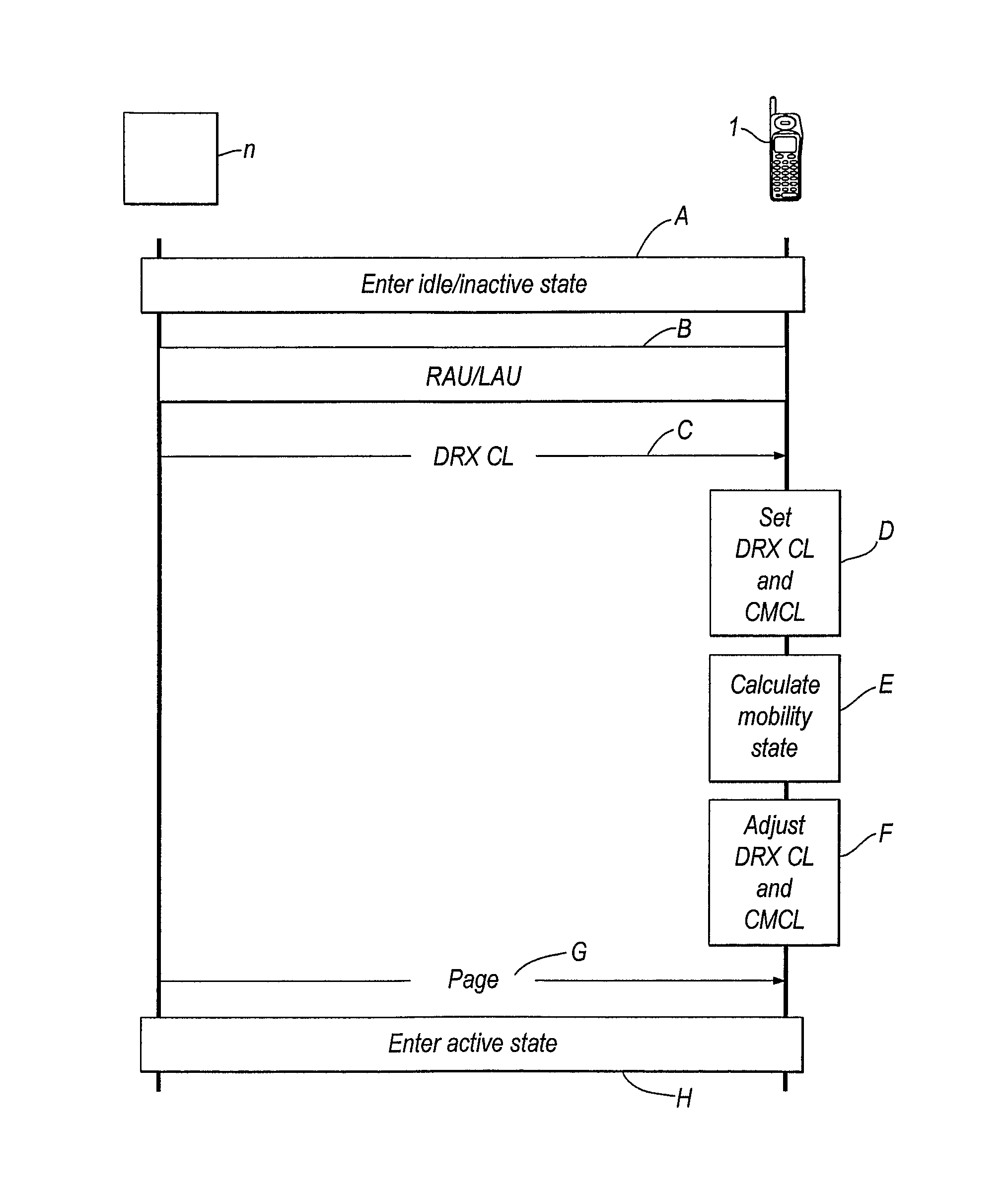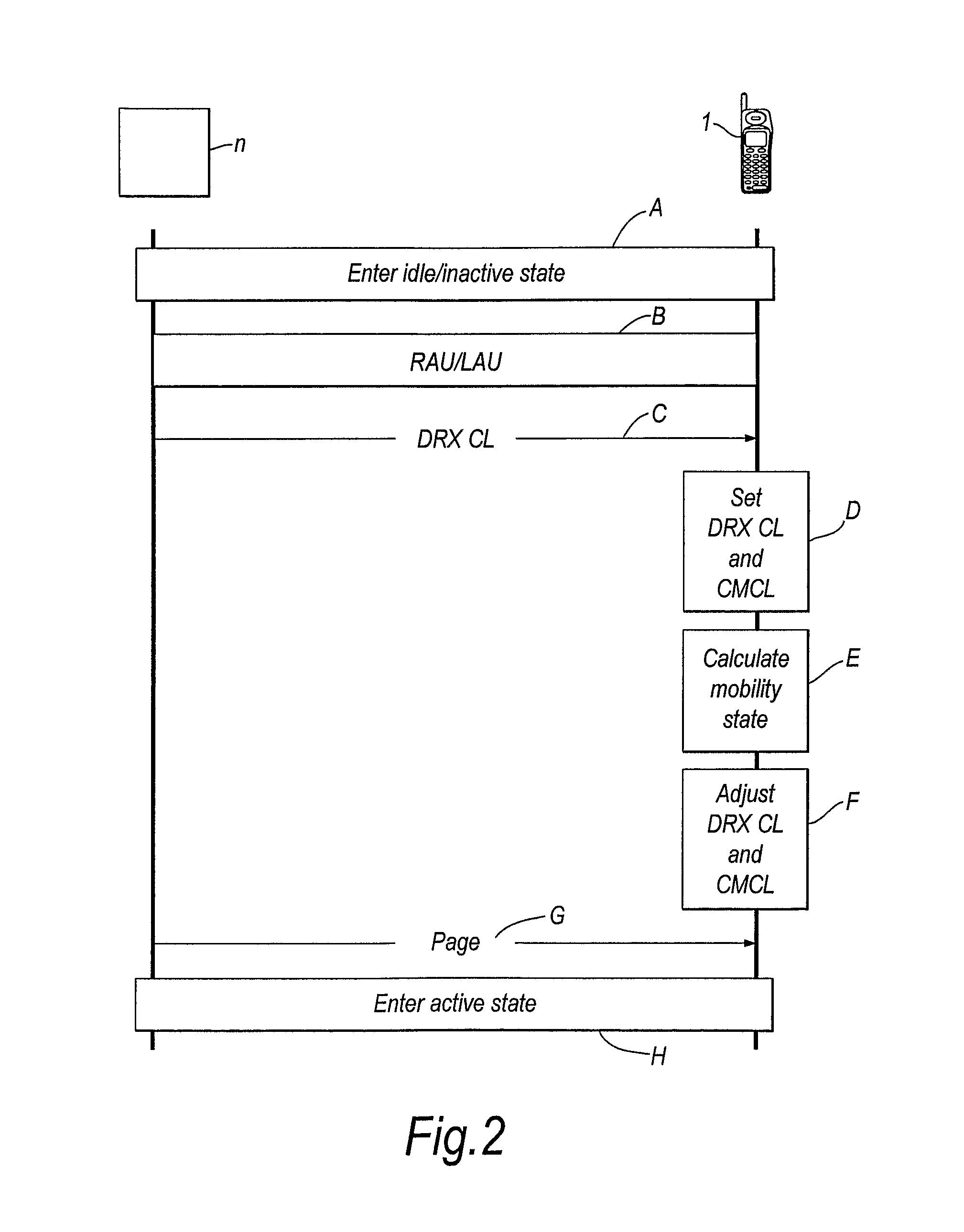Network and Method for Optimizing Cell Reselection by Using an Estimation of Mobility of a Mobile Terminal
a mobile terminal and network optimization technology, applied in the field of mobile or cellular telecommunications network, can solve the problems of disadvantageous setting of cell measurement cycle length in this way, and it is difficult to build a history of mobility state measurement in either the active state or the inactive sta
- Summary
- Abstract
- Description
- Claims
- Application Information
AI Technical Summary
Benefits of technology
Problems solved by technology
Method used
Image
Examples
first embodiment
[0105]An improved solution according to the invention exploits the fact that the mobile terminal (in UMTS) must support a range of DRX cycle lengths. When the mobile terminal is in a state where it is performing “cell re-selection” based on DRX cycles, and the mobile terminal deems that it is moving at high speeds (or low speeds), then in accordance with the embodiment the mobile terminal overrides the DRX Cycle Length (and consequent Cell Measurement Cycle Length) values sent during the last routing / location area update, and selects its Cell Measurement Cycle Length relative to a value that corresponds to a shorter DRX cycle length if this is more appropriate and optimal for the terminal's mobility state.
[0106]FIG. 2 shows the steps performed by the network n and the mobile terminal 1 in the first embodiment of the invention. At step A the mobile terminal enters the idle / inactive state. At step B a routeing area update (RAU) or location area update (LAU) is performed in the convent...
second embodiment
[0114]the invention will now be described.
[0115]In the active state, there are implementation-specific methods for the network to determine whether the mobile terminal is fast-moving or not. This can enable the network to set the handover settings appropriately when the mobile terminal is in an active state, to allow good handover performance, and also it can help the network set network settings accordingly, for example the channel quality reporting frequency for HSDPA.
[0116]Good handover performance means that, when it is moving fast, the mobile terminal does not drop the call due to measurement reporting in the mobile terminal being delayed. When the mobile terminal is moving slowly, it means that the measurement reporting in the mobile terminal is delayed sufficiently to allow the mobile terminal to take enough measurements to average out slow fading of the radio channel.
[0117]From the preceding discussions, it should be clear that mobility is controlled differently in the activ...
third embodiment
[0127]the invention will now be described. In the prior art, when a mobile terminal leaves an “active” RRC state (CELL_DCH in UMTS) it always considers itself as being in “low mobility state” for the selection of the cell reselection parameter to be used. This decision has been taken in the prior art in order to “simplify” the mobile terminal behaviour.
[0128]According to the third embodiment, the mobile terminal initially maintains in the inactive RRC state the “mobility state” that it had when it was in the preceding active CELL_DCH state (e.g. “fast moving” or “slow moving”). In this way the mobile terminal does not have to re-start its “mobility” context when it enters idle state. The “mobility state” from the active state is initially used in the inactive state but can be subsequently changed in accordance with mobility calculations made while the mobile terminal is in the inactive state.
[0129]The third embodiment will now be described in relation to FIG. 5. At step I the active...
PUM
 Login to View More
Login to View More Abstract
Description
Claims
Application Information
 Login to View More
Login to View More - R&D
- Intellectual Property
- Life Sciences
- Materials
- Tech Scout
- Unparalleled Data Quality
- Higher Quality Content
- 60% Fewer Hallucinations
Browse by: Latest US Patents, China's latest patents, Technical Efficacy Thesaurus, Application Domain, Technology Topic, Popular Technical Reports.
© 2025 PatSnap. All rights reserved.Legal|Privacy policy|Modern Slavery Act Transparency Statement|Sitemap|About US| Contact US: help@patsnap.com



